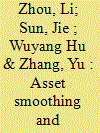|
|
|
Sort Order |
|
|
|
Items / Page
|
|
|
|
|
|
|
| Srl | Item |
| 1 |
ID:
191158


|
|
|
|
|
| Summary/Abstract |
Do households sell assets in order to smooth consumption? The empirical evidence is mixed. Using household- and village-level data in the context of China's poverty alleviation policy, we analyze the relationship between climate shocks and household coping behaviors from the perspective of whether coping strategies to deal with weather shocks are sensitive to the contiguity of destitute areas. Our results indicate that, unlike households living in noncontiguous destitute areas, households struck by weather shocks in contiguous destitute areas tended not to reduce or liquidate assets. To overcome weather shocks, households in contiguous destitute areas instead reduced household consumption, such as food consumption and increased nonfarm working hours. Our findings point to the possibility that the implicit assumption of consumption smoothing coupled with a failure to incorporate explicitly the factor of contiguous regions has led to seemingly divergent findings in the literature regarding consumption smoothing.
|
|
|
|
|
|
|
|
|
|
|
|
|
|
|
|
| 2 |
ID:
130539


|
|
|
|
|
| Publication |
2014.
|
| Summary/Abstract |
This paper measures the economic impacts of climate change on China's grain production by using provincial time series data over a 32-year period. The panel data model and time series region model with/without adaptation are applied at the same time to assess the effectiveness of a common production function. To capture the effects of weather variables we employ a random coefficients model where the production elasticities are the logarithmic function on temperature and rainfall. A Cobb-Douglas production function with additional interaction between inputs and climate variables is applied. We find that the economic impacts of climate change are mixed, that is, some regions are winners and others are losers, and the effect is crop-specific, not general. With adaptation, the economic impacts of warming on grain production are always positive; less precipitation will benefit rice production, but will harm wheat and maize production. Most of the central, western and northern China, which have already been adapted, are less sensitive to climate variables, but some eastern provinces, such as Shandong and Hebei, are very vulnerable. However, this study finds that the adaptation by irrigation is not sensitive to climate change. In summary, the analysis indicates that policymakers should recognize that the climate change would change the productivity of factors, so a regional and crop-specific total-factor-adaptation model is recommended.
|
|
|
|
|
|
|
|
|
|
|
|
|
|
|
|
| 3 |
ID:
147616


|
|
|
|
|
| Summary/Abstract |
This article quantifies the impact of H7N9 bird flu on chicken demand and consumer willingness to pay (WTP) in China. We measure risk perception, fear and trust against actual reduction in consumption and stated change in WTP for safe chicken between 2012 and 2013. Through a survey conducted in each year on the same Chinese urban consumers, we found that the consumption of chicken never increased after the emergence of H7N9 in 2013, and WTP for safe chicken did not necessarily increase relative to generic risks associated with consuming chicken in 2012. Factors such as the fear of H7N9's spreading, the impact of distrust (especially the distrust in government) enhanced the deviation of consumption and WTP; and the sheer mentioning of H7N9 is more important and negative than whether it was associated with a risk-perception reducing or risk-perception elevating message given to consumers.
|
|
|
|
|
|
|
|
|
|
|
|
|
|
|
|
|
|
|
|
|